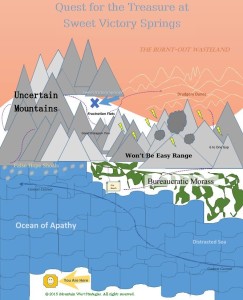Cesar Chavez – “We don’t organize to educate. We educate to organize.”
Sweet Victory!
Think you need a stop sign on the corner? Want to stop a fracking waste pit? Homeowners’ board giving you trouble? Then you might be considering how to develop an ‘advocacy campaign.’ Boiled down, an advocacy campaign is a methodical and strategic approach to reach a specific, time-sensitive goal.
What is advocacy campaigning?
Developing and running an effort to force a specific change: advocacy campaigning starts with a general assumption that the target decision makers need both the rationale and the encouragement (sometime relentless pressure) to take the right action.
The rationale usually comes from a good idea, a needed policy change, or in opposition to a bad one, but it needs to be communicated effectively and delivered well; and there usually needs to be some level of popular or stakeholder support.
It’s all about the campaign goal
The primary reference point for any advocacy campaign is the win—the destination the effort is working to reach.
The campaign itself may be part of a larger movement for change or for a new direction. But for any particular campaign the reference must remain the particular result being sought.
One way to understand the campaign goal is to ask the ‘decision, decider, and deadline’ question. In an advocacy campaign each of those should have a very specific answer.
What about strategies and tactics?
Tactics serve the strategic objective, which can be described as an optimal position to obtain the campaign goal. Strategies describe how the campaign intends to reach certain objectives. Tactics are the necessary steps taken to get to each strategic objective, or more often to reach certain outcomes in a progression toward it.
The main needs of a particular campaign—for instance a good (or winning) proposal, solid communication, and good organizing—often represent three primary strategies many advocacy campaigns deploy: policy, communications, and field strategies. Tactics usually are grouped under these.
As an example, the field strategy objective might be: “Achieve the necessary grassroots support and stakeholder buy-in necessary to compel (swing) decision-maker John to decide correctly on decision-date.”
A stronger strategic objective would include (or be connected with) a specific set of stakeholders and publics you need to engage, such as “Achieve the necessary grassroots support from county voters and stakeholder buy-in from Main St businesses and community opinion leaders necessary to compel (swing) decision-maker John decide correctly on the decision-date.” Field tactics would then work to achieve outcomes that work toward the particulars of that objective.
What make for good tactics?
Good tactics originate in a strong strategic vision—of the overall context and situation, and of the campaign goal. Tactics also rely on clear direction (‘on the ground’), which shows up as situational awareness or ‘tactical vision,’ and manifests as effective action when properly applied.
Martin Luther King Jr.– “A genuine leader is not a searcher for consensus but a molder of consensus.”
In general, good tactics start where those that need organized are at, both in attitude and location, working them toward an anticipated outcome. Good tactics usually also find their initial root in a point of agreement or commonality, and build from that; to solidify and shape that commonality or begin shifting it in a specific direction. Finally good tactics require good timing, and that means being attuned to larger currents and dynamics in play—in the campaign and in the larger arena and world, and being steadfast in pursuit of the campaign goal.
X Marks the Spot: Campaign Plan as your ‘Treasure Map’
Developing an advocacy campaign includes beginning with a good, clear-eyed assessment of the current situation and effort at hand. That information can be used to develop a basic campaign map, or plan, that helps to guide the campaign. Unlike a road map, it does not try to depict every turn and juncture along the way. Rather it shows a destination (goal) and such things as major challenges or opportunities along the way that will need to be overcome or utilized.
The campaign plan itself is built on a timeline that leads up to the deadline, or decision date. Other key events or benchmark dates are also noted, and then tactics are filled in moving forward toward each key date and the deadline, usually grouped by the strategic objective they work toward.
Gandhi – “First they ignore you, then they ridicule you, then they fight you, then you win.”
Frodo had the Fellowship (and Gandalf)
Every adventure needs a team of comrades. And putting together the right campaign plan, and the right campaign team, and being able to guide that smoothly and effectively toward its goal, takes skill, experience and a certain art. Understanding a little of the theory, and the ‘how to’ of developing an advocacy campaign before setting forth can provide a great head start on your quest to a campaign win.
And it may not be a magic ring, but having a wizard involved never hurts either.
Mountain West Strategies provides the strategic consultation to help with your campaign as well as workshops to teach some theory, skills, and provide hands-on training that can help any campaign toward its goal.
Advocacy Campaign Workshops
This post is developed from background materials for a recently introduced series of workshops to teach theory, skills and techniques behind successful advocacy campaigns.
Current workshops being offered include:
- The Art of Advocacy: Finding the Way to the Winning Campaign — a framework for understanding what makes an effective advocacy campaign
- Overview to Campaign Development — covering the ‘nuts and bolts’ steps taken to assess the situation and craft a campaign plan
- Crafting the Winning Campaign — hands on training and practice in campaign development, including campaign assessment and crafting a plan
For more information on workshops, contact Mountain West Strategies at 970-510-0678.


Comments are closed.